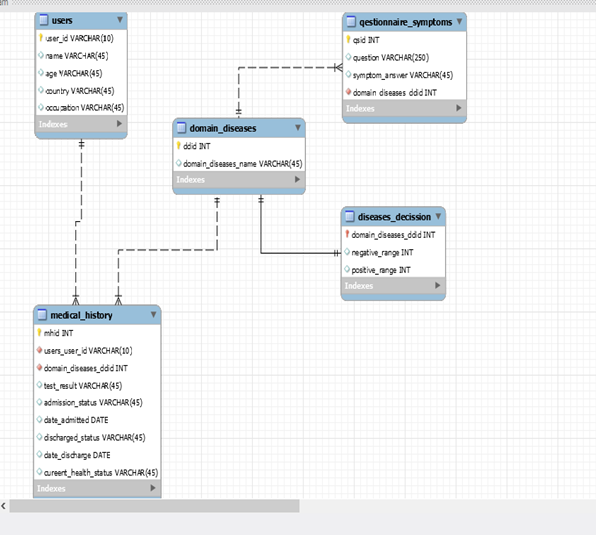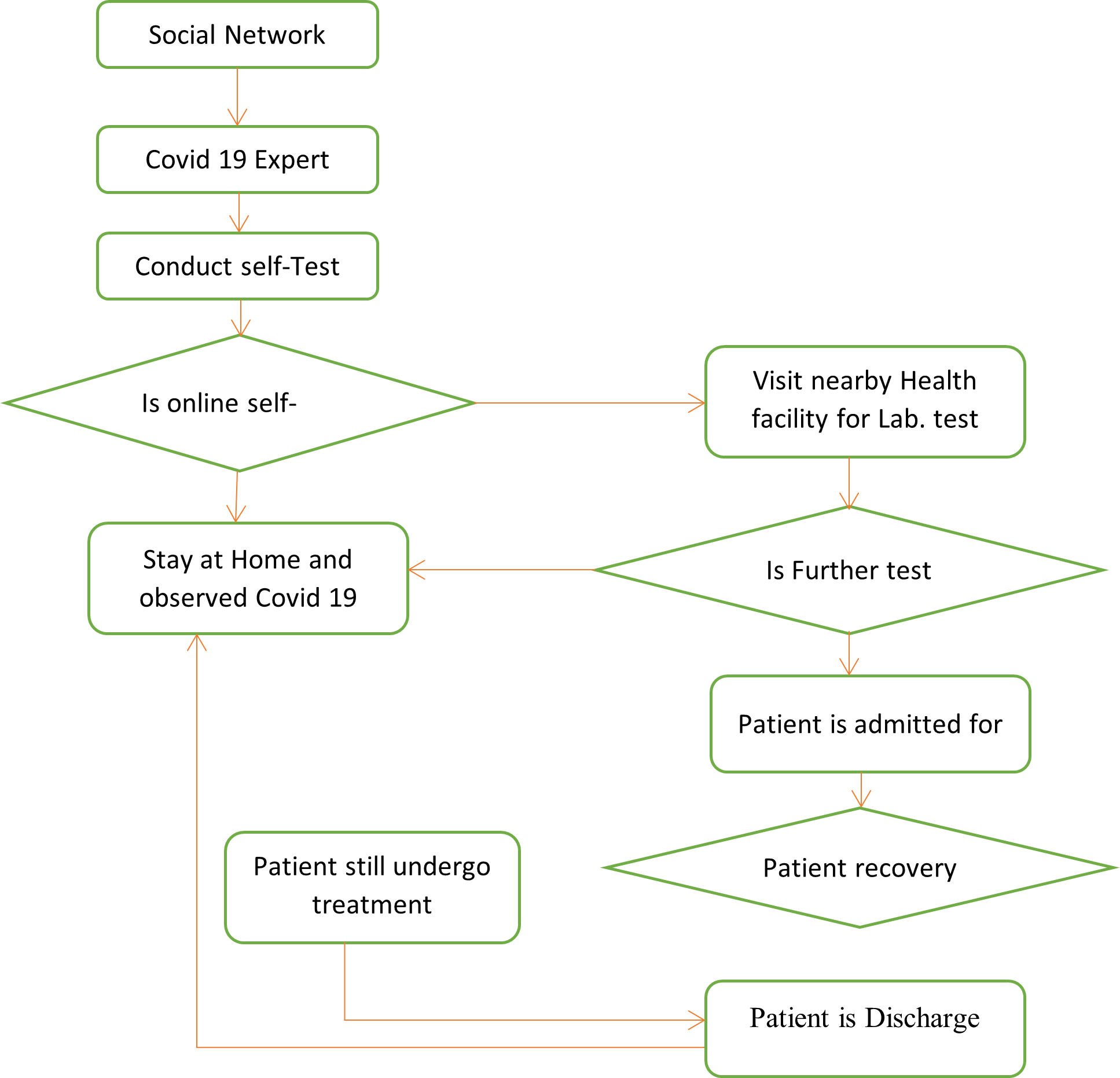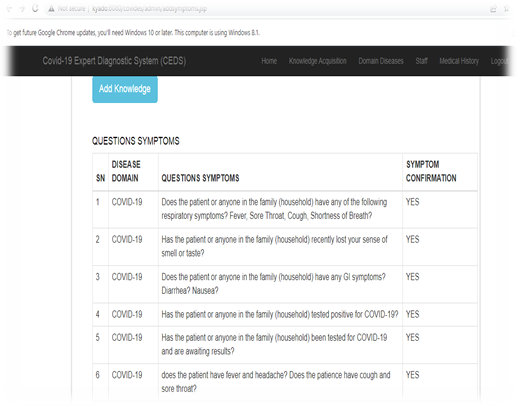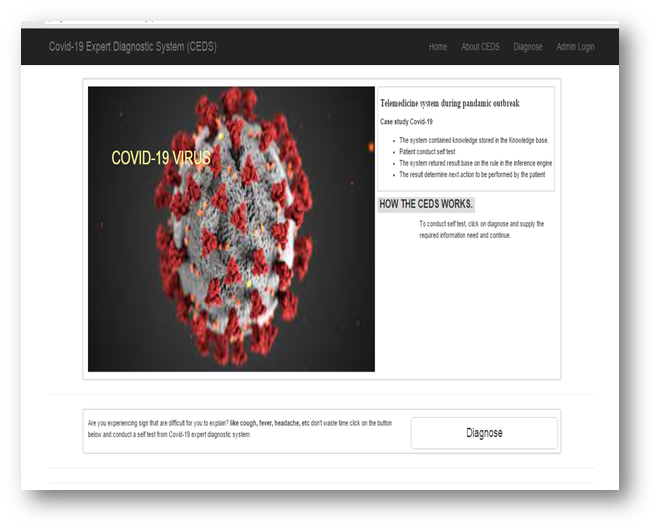Expert System in Telemedicine for the Diagnosis of Corona Virus in Nigeria
- Kyado J. Doris
- Ayua Samuel Iorhemen
- Nnamani U. B.
- Prof. E.J Garba
- 465-473
- Jun 21, 2024
- Healthcare Technology
Expert System in Telemedicine for the Diagnosis of Corona Virus in Nigeria
Kyado J. Doris1, Ayua Samuel Iorhemen2, Nnamani U. B.3, Prof. E.J Garba4
1,2,3Department of Mathematical (Computer Science), Taraba State University, Jalingo, Nigeria
4Computer Science, Modibbo Adama University, Adamawa, Nigeria
DOI: https://doi.org/10.51584/IJRIAS.2024.905041
Received: 01 May 2024; Revised: 13 May 2024; Accepted: 17 May 2024; Published: 21 June 2024
ABSTRACT
In calamitous situations such as Covid-19, patients’ healthcare including medical diagnoses and emergency services are challenged by the risk of infection and by limitations of healthcare resources in developing countries like Nigeria. Couple with the large population and unequal distribution of healthcare resources including physicians and limited healthcare facilities, which has been one of the main factors hampering Nigeria’s response to the COVID-19 crisis. A Covid-19 Self Diagnosis system (CSDS) is designed to provide tools for overcoming the unequal distribution of medical laboratories/ equipment at Covid-19 diagnosis centers in both rural and urban areas in Nigeria. (CSDS) is an expert system that is used for Covid19 diagnoses. The system determine if an end-user is infected with Covid-19 by accepting Covid19- symptoms from the user. An expert system components framework was designed from which the signs and symptoms of Covid 19 Virus were collected into the knowledge base. The Covid 19 Self Diagnoses Model was also designed with the various users’ interfaces. The signs and symptoms of Covid 19 were collected through interview into the knowledge base using Mysql database. Like other expert.
INTRODUCTION
One of the deadliest viral diseases to arise in modern history is the corona virus pandemic of 2019. Its precise process of human emergence is still unknown, as with all previous pandemics (Morens, Breman, & Taubenberger, 2020). Fever, dry cough, and exhaustion were the main symptoms of the outbreak, which also occasionally included gastrointestinal problems. The Huanan Seafood Wholesale Market is a wet seafood wholesale market located in Wuhan, Hubei, China.
Expert systems have been used in telemedicine as a result of the pandemics, which forced the deployment of ever-more-innovative digital technological tactics. In order to help determine whether there is a need or urgency for intervention, telemedicine is typically characterized as a collection of technology and devices that can remotely gather information about a patient’s health status. As a result, it could serve as a screening and diagnostic tool, both of which have been shown to be extremely important in recent research, mostly because of the increased use and advancement of digital technology.
AI (Artificial Intelligence) using expert system, smartphones and digital connections. Appropriate tools allowing clinicians at reaching and periodically monitoring individuals who have difficulties attending specialist visits, especially patients affected by chronic disease (Raffaele, Ciro and Ferdinando 2020). According to Shen, Chen and Wen (2021), telemedicine platforms provide an opportunity of bringing patient and physician together digitally, without requiring physical contact relieving congested clinical services and avoids the risk of further infection, Telemedicine interventions provide at-home solutions allowing clinicians to tele monitor and assess patients remotely, thus minimizing the risk of infection, as in (Gomez, Roberto and Cristina 2021).
It provide medical services at a distance, but some telemedicine gadgets may not be afforded my individuals except government and organizations. According to Oyeranti and Babajide (2020), the increasing cost of health care in developing Countries like Nigeria has called for a change in the way health activities are implemented.
By enhancing early detection and evaluation of infected patients using telemedicine with expert systems, the transmission of the virus will be minimized. Fever, fatigue, and dry cough are the three early and most typical signs of COVID-19 that can be identified using an expert system. Other symptoms to take into account in the expert system ( Dharshikgan, Dass, Meskaran, and Saeedi 2020) are sore throat, diarrhea, nasal congestion, and aches and pains. Without losing a second, the expert system assists patients in real-time symptom detection and diagnosis. In addition to detecting the virus sooner, this type of expert system lessens the effort required of front-line medical staff in diagnosing possible patients. early viral discovery will reduce the death rate and hasten patient recovery since earlier virus detection will boost patient recovery rates. The aim of this effort was to apply expert systems to telemedicine for the diagnosis of corona virus in Nigeria. Its objectives are to:
- Conduct an analysis of the current system by obtaining information from the expert domain
- Use MySQL to create the expert system’s knowledge base
- Create a Model for Covid-19 Self-Diagnosis
LITERATURE REVIEW
An expert system called the Automated Telemedicine and Diagnosis System (ATDS) was developed by Israa A et al. (2019) to diagnose various illnesses, including malaria, and to provide medication. A knowledge base comprises ATDS. By entering the symptoms of the condition, the end user uses it to find out if they have one or more ailments. The user provides information to the system, which then instantly diagnoses and prescribes a medication. Following several tests using various data sets, ATDS’s performance was at its best. Doctor do not have to meet.
The primary goal of ATDS was to deliver emergency medical care in a comfortable and convenient manner. ATDS lowers the high costs associated with frequent hospital visits for patients. ATDS accurately identified the condition and promptly prescribed the necessary medication. Bokolo (2020) In a study titled “Application of telemedicine and e-Health technology for clinical services in response to the corona virus 2019 pandemic,” he talked about how e-Health and telemedicine refer to the use of high-speed telecommunications systems and information and communication technology (ICT) embedded in software programs for the delivery, management, and monitoring of healthcare services, results from this study demonstrate the importance of telemedicine and the contemporary applications that have been used during the epidemic. Strategies used during the pandemic.
RESEARCH METHODOLOGY
Covid 19 signs/symptoms were collected from the expert domain (the medical professionals, nurses, and researchers handling COVID-19 cases); these insights were gathered through expert interviews and entered into the knowledge acquisition unit by the knowledgeable engineer. The knowledge is ingrained in the knowledge base by the engineer. The information gathered from expert interviews about symptom data was divided into three categories: common, chronic, and non-chronic complaints. These were rewritten as questions as shown in table 3.2, which were then rewritten as questions about symptoms as indicated in tab. 3.1.The expert engineer infused these expert subject knowledge into the expert system’s knowledge base. The interference engine can then integrate the two symptoms to ascertain whether the patient has COVID-19 Dass, et al. (2020). The IF…THEN rules are used by the inference engine to draw conclusions from the data.
Table 3.1 Signs/Symptoms of Covid 19
| Common Signs/symptoms | Chronic Signs/Symptoms |
| Fever | Skin rashes |
| Cough | Red eyes |
| Tiredness | Diarrhea |
| Loss of taste | Nausea |
Each of these symptoms were further converted into questions as shown in table 3.2
Table. 3.2 Signs and Questions Symptoms Table
| S/N | Signs/Symptoms Questions |
| 1 | Does the patients have fever and headache? |
| 2 | Does the patience have cough and sore throat? |
| 3 | Is the patient experiencing loss of test or smell? |
| 4 | Does the patient have fever and nausea |
| 6 | Does the patient have fever and diarrhea? |
| 7 | Does the patient have nausea and diarrhea? |
| 8 | Is the patients having skin rashes? |
| 9 | Is the patient having difficulty in breathing? |
| 10 | Is the patient having chest pain and difficulty in breathing |
From the interview it was discovered that, a patient’s recent travel history, the family history in respect to Covid 19, the patient’s occupation and contacts should be considered during Covid 19 Diagnosis facts gathering. Table 3.2.1 shows Covid 19 Screening questions in respect to patients recent traveling history, the patients recent family history in relation to Covid 19, the patients contacts and the patients occupation.
Table 3.3: Screening Questions for Covid-19 Patients
| S/N | QUESTIONS |
| 1 | Has the patient or anyone in the family (household) tested positive for COVID-19? |
| 2 | Has the patient undergone COVID-19 testing and is the family (household) awaiting the results? |
| 3 | Does anyone in the household or family suffer from any of the following respiratory symptoms? Fever, cough, sore throat, difficulty breathing? |
| 4 | Has the patient recently visited any of Nigeria’s heavily affected states or nations? |
KNOWLEDGE BASE
Information Base The expert system’s knowledge is gathered in a unit called the knowledge base. Factual knowledge from medical specialists in the field of the disease was gathered and added to the knowledge base. The expert domain’s COVID-19 symptoms were gathered and added to the knowledge base. The knowledge base, which consists of a rule database “diagnosis,” was implemented using the rule-based technique. These guidelines take the format “if… then.” The expert system’s inference engine stores the expert’s knowledge in rules, allowing it to deliver the user an accurate diagnosis. A component of the knowledge base was the ERD.
DIAGRAM OF AN ENTITY RELATIONSHIP
Entity relationship diagrams provide a visual representation of the tables, entity properties, and relationships within the knowledge base. The knowledgebase design process culminates in the ERD; following this, our tables were constructed. The ER (Entity Relation) diagram of the system, which displays the knowledge kept in the expert system’s knowledge base, is shown in Figure 3.2.2. The relationships between the qualities in a knowledge base and the data items are defined by the ERD.
Fig 3.2 Entity Relationship Diagram (ERD) for the knowledge base
COVID 19 SELF DIAGNOSIS MODEL
The Covid 19 Self Diagnosis Models shows the necessary steps a user interact on the proposed system for self-diagnoses as in figure. 3.4
Step1: the user click on the Covid 19 pop page on the Facebook for self-diagnoses.
Step2: Conduct Self-Test: the user supply his details and continue for self-diagnoses base on the online self-questionnaire. Step3: Consult with an Expert Domain for follow up: Depending on the observation from the expert domain, if the result is negative, the patient will be advice by the system to stay at home and observe the Covid 19 safety rules in order to stay safe. If the result is positive, the system refers the patients to the nearest approved Government facility for observation.
Step4: Further diagnosis by the physician; after observation by a physician and the symptoms persist, the patients is subjected to a Covid 19 test for confirmation of the previous result.
Step 5: Patience go to hosp. for physical test; if the result of the test is negative the patient is discharged, but if the result is confirmed positive, the patient is isolated for treatment.
Fig. 3.4 Covid 19 self Diagnoses Model
RESULT AND DISCUSSION
Signs/Symptoms acquisition interface and view
The knowledge (Covid 19 Signs/Symptoms Questions) acquired from the expert domain are built into the knowledge base through fig.4.3. The questions are sent into the knowledge base using the acquisition interface.
Figure 4.3. Signs/symptoms acquisition interface
COVID 19 EXPERT SYSTEM HOME PAGE
The patient on the Covid 19 self-diagnoses system is able to conduct the diagnose by selecting the Diagnose Button on the home page as in fig. 4.10
Figure 4.10 Covid 19 Self Diagnoses Home Page
CONCLUSION
Covid 19 symptoms questions are kept in the system’s knowledge base and are accessible through the Covid 19 Expert Diagnosis system. Using the system, the patient conducted a self-test and received a result based on the inference engine’s rule.The outcome dictates the patient’s next course of action. An intuitive user interface was used in the development of the Medical Diagnostic Expert System. The expert system and user communicate with each other through the User Interface. It’s the method by which the user interacts with the expert system. A single, user-friendly web interface has been created by integrating the several modules that were used. Patients use the program to get a diagnosis after viewing the pop-up Facebook page. If the domain disease is included in the system knowledge base, the system can be used to diagnose any pandemic. In order to save time and money when referring to medical facilities, patients can also use the system independently. Patients are only eligible to seek care from the closest hospital when the system indicates that they have COVID-19. By enabling patients to self-diagnose, CSDS reduces the amount of effort performed by doctors.
STRENGTHS:
- The study’s main strength is its creative solution to the challenges of Covid-19 in places like Nigeria where resources are limited. The Covid-19 Self Diagnosis System (CSDS) uses expert systems and telemedicine to help diagnose and manage Covid-19 cases remotely. By collecting symptom data from medical experts and turning it into a knowledge base, the system shows a deep understanding of the disease. Making the system easy to use with a friendly interface means people can diagnose themselves, which takes pressure off doctors.
- Also, suggesting to build isolation and immunization centers in rural areas helps make healthcare more equal.
- The study offers a practical way to diagnose Covid-19 in Nigeria and other places facing similar problems.
WEAKNESSES:
- The study about the Covid-19 Self Diagnosis System (CSDS) in Nigeria using expert system technology is informative, but it has some areas that need improvement. Firstly, it doesn’t explain how the system was tested and checked to make sure it gives accurate results. It also doesn’t talk much about how easy it would be to use the system in different situations or if Covid-19 symptoms change.
- Lastly, the study doesn’t mention any problems people might have with using the system or if there are any rules or laws it needs to follow. Fixing these issues would help us understand better how useful the CSDS could be and how it could be improved in the future
SUGGESTIONS:
- The study about the Covid-19 Self Diagnosis System (CSDS) in Nigeria suggests important ways to make it better. Firstly, working with the government and health groups to set up isolation and vaccination centers in rural areas could help everyone get medical help. Secondly, letting public agencies and schools use the CSDS would make it more useful for more people..
- Lastly, adding a virtual voice assistant feature could help patients with disabilities use the system easily, making it better for everyone. These suggestions would improve the CSDS and make it more helpful for remote healthcare.
ACKNOWLEDGEMENTS
The Federal Medical Center team in Jalingo, the Modibo Adama University staff in Adamaqa State, Nigeria, and the Taraba State University staff in Jalingo, Nigeria are all gratefully acknowledged by the writers for their support.
CONFLICTS OF INTEREST
There are no conflicts of interest, according to the authors.
REFERENCES
- A. Boko “Application of telemedicine and eHealth technology for clinical services in response to COVID‑19 pandemic” . Health Technol.11 American Telemedicine Association “2020 doi.org/10.1007,
- S. Dharshikgan, S. Dass, F. Meskaran, and M. Saeedi,: “Expert system for early diagnosis of covid – 19 International” Journal of Current Research and Review: doi.org/10.31782/IJCRR.2020.122227
- M. Gomez-, D. Roberto and T. Cristina “Telemedicine and Virtual Reality at Time of COVID-19 Pandemic”: An Overview for Future Perspectives in Neurore habilitation Empagliflozin in Heart Failure with a Preserved Ejection 2021
- A. Israa, H. Sawsan., A. Rana and A. Haider. “ Automated Telemedicine and Diagnosis System (ATDS) in diagnosing ailments and prescribing drugs”. Periodicals of Engineering and Natural Sciences ISSN 2303-4521 2019 Vol. 7, p 888
- O. Oyeranti.and S. Babajide “Spread of COVID-19 in Nigeria. Centre for Petroleum, Energy Economics and Law (CPEEL), University of Ibadan”. 2020
- D. Morens, J Breman, and L. Taubenberger, “The Origin of COVID-19 and Why It Matters”. The American journal of tropical medicine and hygiene 2020. P 1
- A. Montelongo, R. Roman and M. Gonçalves. ”The management of COVID-19 cases through telemedicine in BrazilL”: 2021 PLoS ON 16(7): 0254339. doi.org/10.1371/journal.pone.0254339.
- G. Raffaele. . C. Ciro. and C. Ferdinando. “The Importance of Telemedicine During COVID-19 Pandemic”: Journal of Diabeties research 2021 p 54-5.
- Y.T Shen, L. Chen. and Wen. “Digital Technology-Based Telemedicine for the COVID-19 Pandemic”. Front. Med. 8:646506. doi: 10.3389/fmed.2021.646506




